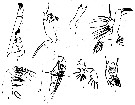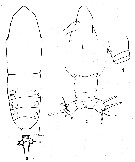
Issued from : F.H. Pineda-Polo
in Bol. Inst. Univ. Oriente, 1979, 18 (1-2). [p.14, Fig.2]
Female: a, A2; b, gnathobase and mandibular palp; c, gnathobase of Md (dorsal view); d, Mx1; e, Mx2; f, Mxp; g, P5; h, P1.
Nota: Endopod of A2 almost 3 times longer than exopod and it ends in a tuft of 6 plumose apical setae; exopod 7-segmented, 1st incompletely separated from the 2nd; segments 2, 3, 4, 5 and 6 bear 1 long plumose seta each, the 7th segment bears 5 long plumose apical setae.
- Md palp well developed with exo and endopod of equal size; endopod 3-segmented, with 2 setae on 1st segment (1 long and 1 short), 2nd segment bears no setae, the last segment bears 5 long setae; exopod 6-segmented, with 1 seta on segments 2, 3, 4 and 5, the last segment bears 3 setae; the gnathobase is curved proximally, with a rather thin arm, the teeth are transversaly set, the 1st one being straight and sharp, flaked by 2 smaller, one on each side and a terminal one, the 2nd one is a little curved and flanked by a tiny tooth found at mid-distance between its tip and the internal bottom edge.
- Mx1 well developed with a strong exopod ending in 3 long plumose curled setae and 2 smaller setae, 1 apical and 1 closer to the base; the 1st outer lobe bears 6 plumose setae , the 2nd outer lobe absent; the 1st inner lobe (= arthrite) bears 2 strong toothed spines and a 3rd strong but plumose spine, besides 2 thinner straight and 1 curled setae; the total number of setae on the 1st inner lobe is 6; the 2nd inner lobe bears 1 seta; the 3rd inner lobe bears 3 setae; the 2nd basipodal segment bears 5 long setae; the one segmented endopod bears 2 short plumose setae.
- Mx2 is strong and well developed; coxa and basis fused, the 1st, 2nd and 4th lobes bear a hairy setae each, the 5th lobe bears a strong toothed and a small naked setae; the 1st segment of the endopodite bears 1 strong and 2 small naked setae, the last 2 segments appear fused, bearing 6 long naked setae.
- Mxp strong, well developed and curved interiorly; basipodite 1 bears 2 straight setae internally and 2 small curved setae close to the exterior side of the base; basipodite 2 bears 2 small but straight internally set setae; the 1st segment of endopod bears 2 long and 2 short setae, the 2nd segment bears 1 long and 1 small setae, the 3rd segment bears 1 long setae, the last segment bears 2 very long and 1 very small setae.
- Both rami of P1 to P4 are 3-segmented.
- P1 has a long hairy setae arising from the internal side of the basipodite 1; the basipodite 2 bears an external dorsally directed seta. The exopodite 1 produces a long and sharp spine that extends well beyond the middle of exopodite 3; exopodite 2 bears 1 small external spine, exopodite 3 bears 3 external spines (1 of them is terminal) and 4 internal setae; the endopodite 1 bears 1 external seta, endopodite 2 bears 1 external and 1 internal setae, endopodite 3 bears 6 setae.
- P5 2-segmented endopodite and exopodite. Endopodite almost forms a straight angle with exopodite 1; basipodite 1 bears 1 internal seta, basipodite 2 bears 1external seta directed ventrally over the setae of the endopodite; endopodite 1 bears 1 internal seta, endopodite 2 bears 7 hairy setae; exopodite 1 produces 1 external spine, exopodite 2 has 3 external spines, 1 of which is terminal plus an apical spine, internally there are 4 hairy setae on exopodite 2.





